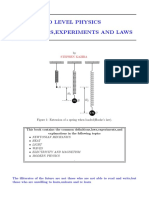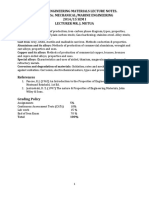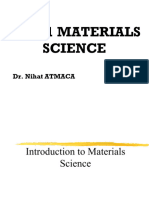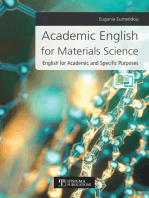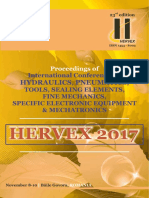0 ratings0% found this document useful (0 votes)
2 viewsIntroduction
The Engineering Materials course covers the fundamental properties of various materials including metals, ceramics, polymers, and composites, focusing on their selection and processing for specific applications. It also addresses corrosion prevention techniques to enhance the longevity of materials. Learning outcomes include classification of material properties, explanation of processing methods, and analysis of corrosion prevention techniques.
Uploaded by
SAJJAL IFTIKHARCopyright
© © All Rights Reserved
Available Formats
Download as PPTX, PDF, TXT or read online on Scribd
0 ratings0% found this document useful (0 votes)
2 viewsIntroduction
The Engineering Materials course covers the fundamental properties of various materials including metals, ceramics, polymers, and composites, focusing on their selection and processing for specific applications. It also addresses corrosion prevention techniques to enhance the longevity of materials. Learning outcomes include classification of material properties, explanation of processing methods, and analysis of corrosion prevention techniques.
Uploaded by
SAJJAL IFTIKHARCopyright
© © All Rights Reserved
Available Formats
Download as PPTX, PDF, TXT or read online on Scribd
You are on page 1/ 30
Engineering Materials
Course Introduction
This course aims to describe the basics properties of engineering
materials so that one can choose the most suitable material of
construction for specific application and develop best processing
method. The course also aims to explain different corrosion prevention
technique so engineering material of construction can achieve their
design life.
Course Outline
Course Contents
1. Properties of Materials:
Material sciences and engineering. Classification of materials Metal, Ceramics, Polymers, Composite. Advance
materials semi-conductors. Biomaterials, Smart materials. Atomic structure and bonding. Metallic crystal
structures FCC, BCC. Concept of stress and strain. Elastic deformation. Plastic Deformation. True stress True Strain,
Ductility, Fracture. Hardness Test Rockwell, Brinell ,knoop test.
2. Metals Ferrous and Non Ferrous Alloys:
Classification of ferrous and non-ferrous alloys. Iron occurrence. Extraction of iron blast furnace. Iron-Iron Carbide
phase diagram. Austenite,α ferrite, cementite etc. forms of iron. Classification of cast iron. Making of steel
Bessemer process, Basic oxygen furnace. Types of steel w.r.t carbon content. Types of stainless steel. Some other
alloys. Heat treatment of steel annealing, Normalizing, Hardening Tempering, Fabrication of metals/Metals
forming processes hot working/Cold working. On-Ferrous alloys. Extraction of copper from ores.
Roasting/Smelting operations. Electrolytic extraction. Fire refining. Different alloys of copper and their properties
applications. Nickel chromium, Aluminum magnesium alloys
3. Composite, Polymer, Ceramics:
Polymer classification, structure, processing, additives and polymers general properties/applications, Engineering
thermoplastic materials PVC, Teflon/PTFE, PET, PBT, Poly-olefins properties, application. Ceramics classification
clay/refractor/Glasses, Cement general properties and applications, Fire clay, Silica, Basic refractories. Glass
ceramics types, properties, processing and applications. Advance ceramics, Composites properties, processing
applications, Fiber reinforced. Polymer matrix composites.
4. Corrosion and Testing/Selection of materials:
Types of corrosion, Galvanic, Pitting, crevice, stress corrosion, erosion etc. and their prevention techniques.
Corrosion environments, General corrosion Prevention. Cathodic Protection, Surface treatment etc. Degradation of
polymers, Swelling Dissolution etc. Selection of materials. International standards for materials testing,
destructive and nondestructive testing techniques.
Course Learning Outcome
No. CLO PLO Cognitive/Psychomotor/Affective level
To be able to classify the fundamental properties
such as (Mechanical, chemical, structural and
1 thermal) for materials of construction like (Metal, 1 C2
Ceramics, Polymer, Composites and advanced
materials)
To be able to explain the properties, processing and
2
applications of materials of construction. 1 C2
To be able to analyze different corrosion prevention
3 techniques and selection of suitable technique as 7 C2
per requirement.
To be able to analyze different parameters of
4
material selection and select expedient material. 2 C4
MATERIALS SCIENCE AND ENGINEERING
The discipline of materials science involves
investigating the relationships that exist between
the structures and properties of materials.
In contrast, materials engineering is, on the basis
of these structure–property correlations, designing
or engineering the structure of a material to
produce a predetermined set of properties.
Throughout this text we draw attention to the
relationships between material properties and
structural elements
important properties of solid materials
May be grouped into six different categories:
Mechanical
Electrical
Thermal
Magnetic
Optical
Deteriorative
Mechanical properties
Relate deformation to an applied load or force;
examples include elastic modulus and strength
Electrical properties
Electrical conductivity and dielectric constant, the
stimulus is an electric field
Thermal Properties
Thermal behavior of solids can be represented in
terms of heat capacity and thermal conductivity
Magnetic Properties
Demonstrate the response of a material to the
application of a magnetic field.
Optical properties
The stimulus is electromagnetic or light radiation;
index of refraction and reflectivity
Deteriorative Properties
Indicate the chemical reactivity of materials.
• In addition to structure and properties, two other
important components are involved in the science
and engineering of materials, viz. ‘‘processing’’ and
‘‘performance.’’
• With regard to the relationships of these four
components, the structure of a material will depend
on how it is processed. Furthermore, a material’s
performance will be a function of its properties.
CLASSIFICATION OF MATERIALS
• Solid materials have been conveniently grouped
into three basic classifications: metals, ceramics,
and polymers.
This scheme is based primarily on chemical
makeup and atomic structure, and most materials
fall into one distinct grouping or another, although
there are some intermediates
In addition, there are three other groups of
important engineering materials—composites,
semiconductors, and biomaterials.
• Composites consist of combinations of two or
more different materials, whereas
• semiconductors are utilized because of their
unusual electrical characteristics
• Biomaterials are implanted into the human body.
METALS
• Metallic materials are normally combinations of metallic
elements.
• They have large numbers of no localized electrons; that is,
these electrons are not bound to particular
atoms.
• Many properties of metals are directly attributable to these
electrons. Metals are extremely good conductors of
electricity and heat and are not transparent to
visible light; a polished metal surface has a lustrous
appearance.
• Furthermore, metals are quite strong, yet deformable,
which accounts for their extensive use in structural
applications.
CERAMICS
• Ceramics are compounds between metallic and
nonmetallic elements
• They are most frequently oxides, nitrides, and carbides.
• The wide range of materials that falls within this
classification includes ceramics that are composed of
clay minerals, cement, and glass.
• These materials are typically insulative to the passage
of electricity and heat, and are more resistant to high
temperatures and harsh environments than metals and
polymers.
• With regard to mechanical behavior, ceramics are hard
but very brittle.
POLYMERS
• Polymers include the familiar plastic and rubber
materials.
• Many of them are organic compounds that are
chemically based on carbon, hydrogen, and
other nonmetallic elements;
• Furthermore, they have very large molecular
structures.
• These materials typically have low densities and
may be extremely flexible.
COMPOSITES
• A number of composite materials have been
engineered that consist of more than one material
type. Fiberglass is a familiar example, in which glass
fibers are embedded within a polymeric material.
• A composite is designed to display a combination
of the best characteristics of each of the
component materials.
• Fiberglass acquires strength from the glass and
flexibility from the polymer.
• Many of the recent material developments have
involved composite materials.
SEMICONDUCTORS
• Semiconductors have electrical properties that are
intermediate between the electrical conductors and
insulators.
• Furthermore, the electrical characteristics of these
• materials are extremely sensitive to the presence of
minute concentrations of impurity atoms, which
concentrations may be controlled over very small
spatial regions.
• The semiconductors have made possible the advent
of integrated circuitry that has totally revolutionized
the electronics and computer industries (not to
mention our lives) over the past two decades
BIOMATERIALS
• Biomaterials are employed in components
implanted into the human body for
replacement of diseased or damaged body
parts.
• These materials must not produce toxic
substances and must be compatible with body
tissues (i.e., must not cause adverse biological
reactions).
• All of the above materials—metals, ceramics,
polymers, composites, and semiconductors—
may be used as biomaterials.
ADVANCED MATERIALS
• Materials that are utilized in high-technology (or high-tech)
applications are sometimes termed advanced materials.
• By high technology we mean a device or product that
operates or functions using relatively intricate and
sophisticated principles; examples include electronic
equipment (VCRs, CD players, etc.), computers, fiberoptic
systems, spacecraft, aircraft, and military rocketry.
• These advanced materials are typically either traditional
materials whose properties have been enhanced
• Newly developed, high-performance materials.
Furthermore, they may be of all material types (e.g.,
metals, ceramics, polymers), and are normally relatively
expensive.
Periodic Table and Atomic Bonding
Primary Bonding
Secondary Bonding
Struture of Metals
• Solid materials may be classified according to the regularity
with which atoms or ions are arranged with respect to one
another.
• A crystalline material is one in which the atoms are situated in
a repeating or periodic array over large atomic distances; that
is, long-range order exists, such that upon solidification, the
atoms will position themselves in a repetitive three-
dimensional pattern, in which each atom is bonded to its
nearest-neighbor atoms.
• All metals, many ceramic materials, and certain polymers
form crystalline structures under normal solidification
conditions.
• For those that do not crystallize, this long-range atomic order
is absent; these are noncrystalline or amorphous materials
UNIT CELLS
• The atomic order in crystalline solids indicates that small
groups of atoms form a repetitive pattern. Thus, in
describing crystal structures, it is often convenient to
subdivide the structure into small repeat entities called
unit cells.
• Unit cells for most crystal structures are parallelepipeds
or prisms having three sets of parallel faces; one is
drawn within the aggregate of spheres (Figure 3.1c),
which in this case happens to be a cube.
• A unit cell is chosen to represent the symmetry of the
crystal structure, wherein all the atom positions in the
crystal may be generated by translations of the unit cell
integral distances along each of its edges.
METALLIC CRYSTAL STRUCTURES
THE FACE-CENTERED CUBIC CRYSTAL STRUCTURE
• The crystal structure found for many metals has a
unit cell of cubic geometry, with atoms located at
each of the corners and the centers of all the
cube faces.
• It is aptly called the face-centered cubic (FCC)
crystal structure. Some of the familiar metals
having this crystal structure are copper,
aluminum, silver, and gold
THE BODY-CENTERED CUBIC CRYSTAL
STRUCTURE
• Another common metallic crystal structure
also has a cubic unit cell with atoms located at
all eight corners and a single atom at the cube
center.
• This is called a body-centered cubic (BCC)
crystal structure
• Two atoms are associated with each BCC unit
cell: the equivalent of one atom from the eight
corners,
• Each of which is shared among eight unit cells,
and the single center atom, which is wholly
contained within its cell.
• In addition, corner and center atom positions
are equivalent.
• The coordination number for the BCC crystal
structure is 8; each center atom has as nearest
neighbors its eight corner atoms
THE HEXAGONAL CLOSE-PACKED CRYSTAL
STRUCTURE
• Not all metals have unit cells with cubic
symmetry; the final common metallic crystal
structure to be discussed has a unit cell that is
hexagonal.
• Figure 3.3a shows a reduced-sphere unit cell
for this structure, which is termed hexagonal
close-packed (HCP);
• The top and bottom faces of the unit cell consist of
six atoms that form regular hexagons and
surround a single atom in the center.
• Another plane that provides three additional
atoms to the unit cell is situated between the top
and bottom planes.
• The atoms in this midplane have as nearest
neighbors atoms in both of the adjacent two
planes.
• The equivalent of six atoms is contained in each
unit cell; one-sixth of each of the 12 top and
bottom face corner atoms, one-half of each of the
2 center face atoms, and all the 3 midplane
interior atoms.
You might also like
- Excersises For Essentials and Engineering of MaterialsNo ratings yetExcersises For Essentials and Engineering of Materials5 pages
- Lecture 1 - Introduction To Materials ScienceNo ratings yetLecture 1 - Introduction To Materials Science32 pages
- Bonga University: Engineering Material (Meng2091)100% (1)Bonga University: Engineering Material (Meng2091)19 pages
- Introduction To Materials Science & EngineeringNo ratings yetIntroduction To Materials Science & Engineering30 pages
- Emt 2132 Introduction To Material Science PDFNo ratings yetEmt 2132 Introduction To Material Science PDF52 pages
- Introduction to Materials Engineering 2 5No ratings yetIntroduction to Materials Engineering 2 54 pages
- Emg 2201 Engineerinr Materials Lecture NotesNo ratings yetEmg 2201 Engineerinr Materials Lecture Notes18 pages
- Introduction To Materials and Processes PDFNo ratings yetIntroduction To Materials and Processes PDF0 pages
- EMG 2104 Intoduction To Material ScienceNo ratings yetEMG 2104 Intoduction To Material Science73 pages
- Lecture 1. Introduction to Material Science Rev1No ratings yetLecture 1. Introduction to Material Science Rev137 pages
- (Stone Age, Bronze Age, and Iron Age) : Design, Production, and Utilization of MaterialsNo ratings yet(Stone Age, Bronze Age, and Iron Age) : Design, Production, and Utilization of Materials8 pages
- Materials Science and Engineering: An IntroductionNo ratings yetMaterials Science and Engineering: An Introduction22 pages
- FINAL - Engineering Materials (Lecture 1)No ratings yetFINAL - Engineering Materials (Lecture 1)89 pages
- Material Science: Prof. Satish V. KailasNo ratings yetMaterial Science: Prof. Satish V. Kailas19 pages
- 04.materials Selection in Engineering Modeling INo ratings yet04.materials Selection in Engineering Modeling I15 pages
- Guidance Note: Heritage Railway AssociationNo ratings yetGuidance Note: Heritage Railway Association23 pages
- Characterisation of Composite Materials in Railways For Structural Calculations100% (2)Characterisation of Composite Materials in Railways For Structural Calculations60 pages
- Simulation Based Aerosol Can Design Under PressureNo ratings yetSimulation Based Aerosol Can Design Under Pressure13 pages
- Study of Mechanical Properties of LaB6 Single Crystal by Nano IndentationNo ratings yetStudy of Mechanical Properties of LaB6 Single Crystal by Nano Indentation8 pages
- Instant Download Dynamic Behavior of Materials, Volume 1: Proceedings of the 2015 Annual Conference on Experimental and Applied Mechanics 1st Edition Bo Song PDF All ChaptersNo ratings yetInstant Download Dynamic Behavior of Materials, Volume 1: Proceedings of the 2015 Annual Conference on Experimental and Applied Mechanics 1st Edition Bo Song PDF All Chapters55 pages
- ASTM D695-Compressive Properties of Rigid PlasticsNo ratings yetASTM D695-Compressive Properties of Rigid Plastics7 pages
- Advanced Steel Design of Structures 1st Edition Srinivasan Chandrasekaran (Author) - The complete ebook is available for download with one click100% (3)Advanced Steel Design of Structures 1st Edition Srinivasan Chandrasekaran (Author) - The complete ebook is available for download with one click47 pages
- Chapter 2 Griffith Theory of Fracture - 2012 - Fracture Mechanics PDFNo ratings yetChapter 2 Griffith Theory of Fracture - 2012 - Fracture Mechanics PDF14 pages
- Subject Title: Strength of Materials Class: Second Year: Instructor Name: Dr. Ziad Sh. AL SarrafNo ratings yetSubject Title: Strength of Materials Class: Second Year: Instructor Name: Dr. Ziad Sh. AL Sarraf46 pages
- Dynamic Behavior of Materials,: Steven Mates Veronica Eliasson EditorsNo ratings yetDynamic Behavior of Materials,: Steven Mates Veronica Eliasson Editors113 pages
- General Principles of Flexible Pavement DesignNo ratings yetGeneral Principles of Flexible Pavement Design67 pages
- Gardner2005 TheuseofstainlesssteelinstructuresNo ratings yetGardner2005 Theuseofstainlesssteelinstructures39 pages
- Excersises For Essentials and Engineering of MaterialsExcersises For Essentials and Engineering of Materials
- (Stone Age, Bronze Age, and Iron Age) : Design, Production, and Utilization of Materials(Stone Age, Bronze Age, and Iron Age) : Design, Production, and Utilization of Materials
- Materials Science and Engineering: An IntroductionMaterials Science and Engineering: An Introduction
- Academic English for Materials: Academic EnglishFrom EverandAcademic English for Materials: Academic English
- Characterisation of Composite Materials in Railways For Structural CalculationsCharacterisation of Composite Materials in Railways For Structural Calculations
- Simulation Based Aerosol Can Design Under PressureSimulation Based Aerosol Can Design Under Pressure
- Study of Mechanical Properties of LaB6 Single Crystal by Nano IndentationStudy of Mechanical Properties of LaB6 Single Crystal by Nano Indentation
- Instant Download Dynamic Behavior of Materials, Volume 1: Proceedings of the 2015 Annual Conference on Experimental and Applied Mechanics 1st Edition Bo Song PDF All ChaptersInstant Download Dynamic Behavior of Materials, Volume 1: Proceedings of the 2015 Annual Conference on Experimental and Applied Mechanics 1st Edition Bo Song PDF All Chapters
- ASTM D695-Compressive Properties of Rigid PlasticsASTM D695-Compressive Properties of Rigid Plastics
- Advanced Steel Design of Structures 1st Edition Srinivasan Chandrasekaran (Author) - The complete ebook is available for download with one clickAdvanced Steel Design of Structures 1st Edition Srinivasan Chandrasekaran (Author) - The complete ebook is available for download with one click
- Chapter 2 Griffith Theory of Fracture - 2012 - Fracture Mechanics PDFChapter 2 Griffith Theory of Fracture - 2012 - Fracture Mechanics PDF
- Subject Title: Strength of Materials Class: Second Year: Instructor Name: Dr. Ziad Sh. AL SarrafSubject Title: Strength of Materials Class: Second Year: Instructor Name: Dr. Ziad Sh. AL Sarraf
- Dynamic Behavior of Materials,: Steven Mates Veronica Eliasson EditorsDynamic Behavior of Materials,: Steven Mates Veronica Eliasson Editors
